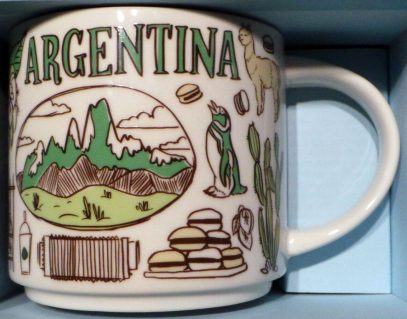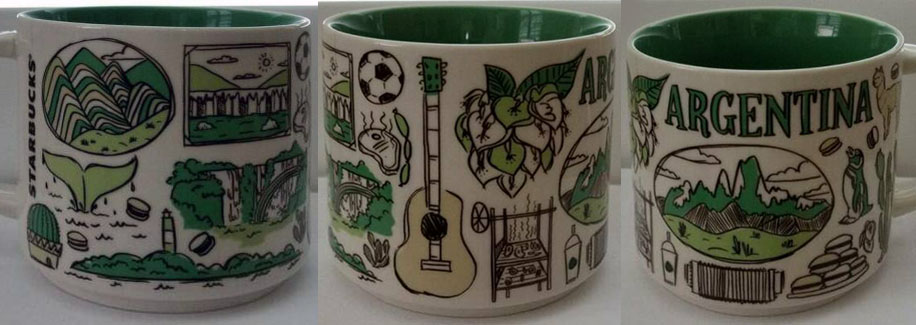
Been There – Argentina
I can finally get back and review some mugs from South America released through 2018-2019. Let me start with Been There – Argentina. This one is designed using green colors. Most of the symbols from the mug represent flora and fauna of the country. Here’s what I was able to identify:
– The Andes is the longest continental mountain range in the world which stretches across all South America. It is the highest mountain range outside of Asia with the highest mountain Aconcagua being 22,837ft (6,960.8 meters) high. I believe it is the one which occupies the big part of the front of the mug. From the climbing perspective, it is an “easy” mountain since getting to the summit using the north route doesn’t require ropes, axes, and pins. Some climbers, however, will have to use oxygen masks due to elevation. Despite the ease of the climb, casualties happen at an approximate rate of 3 per year hence the nickname “Mountain of Death”. Most of the cases are the result of climbers underestimating the harsh conditions, especially wind and cold.
– The cute fluffy animal in the top right corner is Alpaca, I believe. It is very similar to Llama but is smaller, has a blunt face shorted ears and legs. Both Alpacas and llamas are also closely related to the vicuña, which is believed to be the alpaca’s wild ancestor, and to the guanaco. The latter are widely spread in wild in Patagonia.
– a plate with what I believed were “hamburgers” at first, turned out to be alfajores – sandwich-style cookies which are very popular in Argentina and to less extent in other adjacent countries. The classic filling in Argentina is dulce de leche, however many other variations exist.
– The bandoneon is a musical instrument which is pretty popular in Argentina. It was brought to the country at around 1870 by German and Italian immigrants. It was later adopted as an essential instrument in most tango ensembles.
– The whale fluke on the back of the mug belongs to Southern Right Whale which is known to play this tail sailing game, using their elevated flukes to catch the wind, remaining in the same position for a while.
– The soccer ball is obviously a symbol of one of the most popular sports in Argentina. Throughout the years it became a part of Argentinian culture being played from childhood into old age. The Argentina national team won the FIFA World Cup twice, in 1978 and 1986.
– Magellanic Penguin is native to Chile, Argentina and Falkland Islands. Latter region, however, experienced a significant decline in population due to commercial fishing (hence leaving penguins with little food). Penguins are interesting in a sense that distinguishing them is quite a challenge even for scientists. And while it’s hard to draw a line between different species, it’s safe to say that waters of Argentinian coasts are home to many more type of penguins, like Rockhopper, Macaroni, Gentoo, King, and Humboldt.



















































































